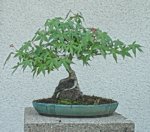James W.
Chumono
When I do a search for root over rock I find get quite a few "how to" hits and a good number of people starting one. I find very few examples of finished trees, especially species other than trident maples or ficus. And start to finish progressions are not to be found.
Is this because no one likes them? or because they are difficult and so time consuming they are not done often or never finished? or because lots of people try it and they all turn out ugly?
Is this because no one likes them? or because they are difficult and so time consuming they are not done often or never finished? or because lots of people try it and they all turn out ugly?
Last edited:











